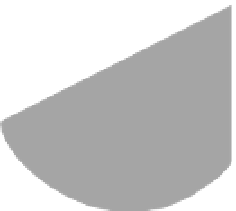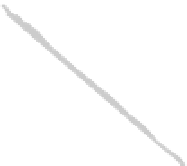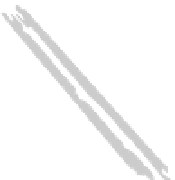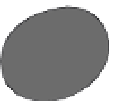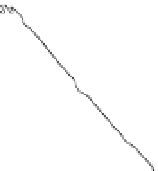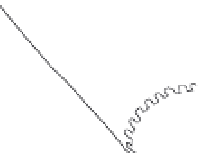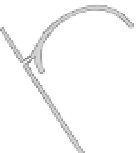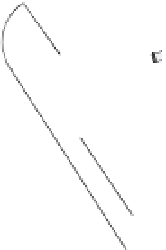Biomedical Engineering Reference
In-Depth Information
SARCOPLASMIC
RETICULUM
ACTIN AND
MYOSIN
FILAMENTS
SARCOLEMMA
TRANSVERSE
TUBULE
SARCOPLASM
NUCLEUS
MYOFIBRIL
MITOCHONDRIA
FIGURE 3.37
Skeletal muscles are composed of muscle fascicles that are composed of muscle fibers such as the
one shown here. Muscle fibers have hundreds of nuclei just below the plasma membrane—the sarcolemma. Trans-
verse tubules extend into the sarcoplasm, the cytoplasm of the muscle fiber, and are important in the contraction
process because they deliver action potentials that result in the release of stored calcium ions. Calcium ions are
needed to create active sites on actin filaments so cross-bridges can be formed between actin and myosin and
the muscle can contract.
In muscle fibers, the plasma membrane is called the sarcolemma, and the cytoplasm is
called the sarcoplasm (Figure 3.37). Transverse tubules (T tubules) begin at the sarco-
lemma and extend into the sarcoplasm at right angles to the surface of the sarcolemma.
The T tubules, which play a role in coordinating contraction, are filled with extracellular
fluid and form passageways through the muscle fiber. They make close contact with
expanded chambers, cisternae, of the sarcoplasmic reticulum, a specialized form of the
ER. The cisternae contain high concentrations of calcium ions that are needed for contrac-
tion to occur.
The sarcoplasm contains cylinders 1 or 2
m in diameter that are as long as the entire
muscle fiber and are called myofibrils. The myofibrils are attached to the sarcolemma at each
end of the cell and are responsible for muscle fiber contraction. Myofilaments—protein fila-
ments consisting of thin filaments (primarily actin) and thick filaments (mostly myosin)—
are bundled together to make up myofibrils. Repeating functional units of myofilaments
are called sarcomeres (Figure 3.38). The sarcomere is the smallest functional unit of the mus-
cle fiber and has a resting length of about 2.6
m
m. The thin filaments are attached to dark
bands, called Z lines, which form the ends of each sarcomere. Thick filaments containing
double-headed myosin molecules lie between the thin ones. It is this overlap of thin and thick
filaments that gives skeletal muscle its banded, striated appearance. The I band is the area in
a relaxed muscle fiber that just contains actin filaments, and the H zone is the area that just
contains myosin filaments. The H zone and the area in which the actin and myosin overlap
form the A band.
When a muscle contracts, myosin molecules in the thick filaments form cross-bridges at
active sites in the actin of the thin filaments and pull the thin filaments toward the center of
m

